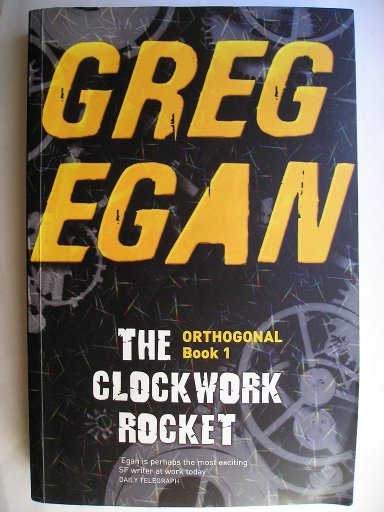
The novel “The Clockwork Rocket” by Greg Egan was published for the first time in 2011. It’s the first book of the Orthogonal trilogy.
Yalda lives on a farm but that environment is too limited for her curiosity. Luckily for her, her father had promised her mother to send her to school so Yalda can to get a education higher than her relatives’. Eventually, she even manages to become a university teacher but life isn’t easy for her.
Yalda tries to discover the secrets of the universe but the problems come not only from the society in which she lives but also from a possible danger. As a child, she saw some strange meteors entering the planetary system at a very high speed. Over time, this phenomenon has become more intense and could become a threat to the whole planet.
Greg Egan is one of the most important authors of hard science fiction as in his stories scientific and technological ideas are fundamental. The Orthogonal trilogy is even set in another universe with different laws of physics and their discovery is a part of the plot.
The readers familiar with Greg Egan already know they have to expect a rather complex reading in its scientifically and/or technological contents, “The Clockwork Rocket” is ambitious even by his standards. To help those who don’t have a degree in physics, the author added an appendix to the novel that explains in more detail the physics on light and colors in the universe in which the trilogy is set.
On his website, Greg Egan also added a section with further explanations which are a sort of handbook explaining the physics of that universe. The author warns that in some ways it caontains conceptual spoilers precisely because they are revealed in the course of the novel, however, reading at least the introduction to those physical laws can help you understand if this trilogy can be stimulating or too heavy for your taste.
At the end of “The Clockwork Rocket” only one story ends while the others, braoder, continue in its sequels. For this reason, you should try to figure out if you can like the Orthogonal trilogy to avoid abandoning it after the first novel without seeing a real conclusion.
Physics is by far the most developed subject in “The Clockwork Rocket” but it’s not the only important one. The characters of the novel are native to that universe and physically are completely different from humans. They’re shapeshifters with physical characteristics that are partly discovered in the course of the story and some of them are important to the plot. This is seen from the beginning, when Yalda’s curiosity is stimlated by the phenomena that accompany the death of her grandfather Dario.
Curiously, in this environment so alien the characters tend to have Italian names and the prefixes for multiples and fractions of the units of measurement are Italian as well. Maybe for an Australian author Italy is alien enough to be a source of inspiration when writing a trilogy like this one.
These are not the only elements that may be familiar to us because the society described in the novel has some aspects we can easily recognize. Unfortunately, in general the similarities with human societies are in downsides such as politics full of backstabbing, the fact that women are second class citizens or police brutality.
Greg Egan makes a clear choice in creating a society we can recognize in which the protagonist Yalda works in scientific advancement overcoming prejudice and facing various social problems. Yalda is a person out of the ordinary because she doesn’t have a twin and ends up connecting with other people who for some reasons are misfits.
Social themes of “The Clockwork Rocket” are sometimes overshadowed by the elements of physics and they are not the only ones. In the novel there are not only scientific developments from the theoretical point of view but also experimental and there are many technological advancements. However, Greg Egan focuses on the theoretical aspects by providing only basic information about everything else.
Nevertheless, the story of Yalda and her people is far from confined in some university classroom. On the contrary, theoretical physics is part of a dramatic story in which a society with a limited level of technology develops rocket science very quickly. From this point of view, the novel contains what can be called a sort of alien steampunk.
“The Clockwork Rocket” follows Yalda’s story for several years, occasionally leaping forward in time. Because of the long scientific explanations the narrative pace is generally slow with a limited amount of action. Yalda is the absolute protagonist and the only character who appears in all of the story so she’s by far the most developed.
“The Clockwork Rocket” isn’t a novel for everyone but I think it’s really good. The previous novels by Greg Egan convinced me only in part but in this first book of the Orthogonal trilogy I find that once again he developed huge scientific speculations in a satisfactory story. If you like hard science fiction I recommend it.


Permalink
Permalink